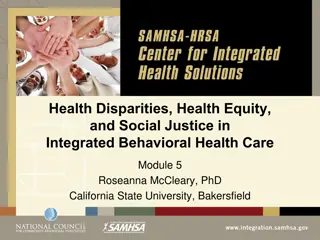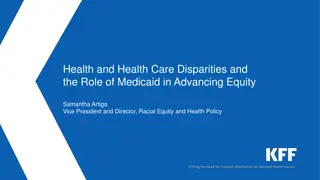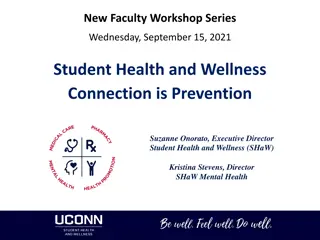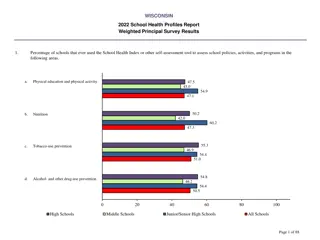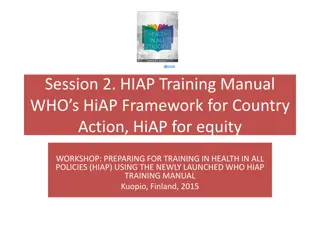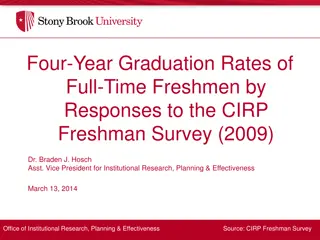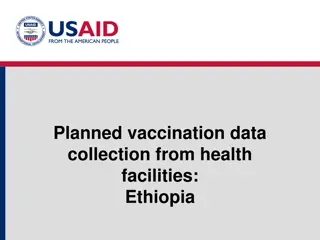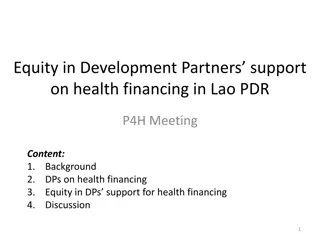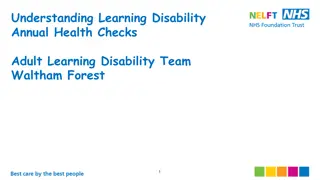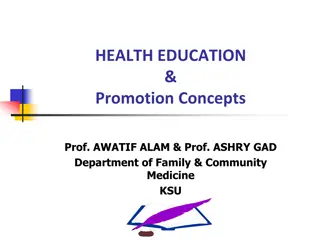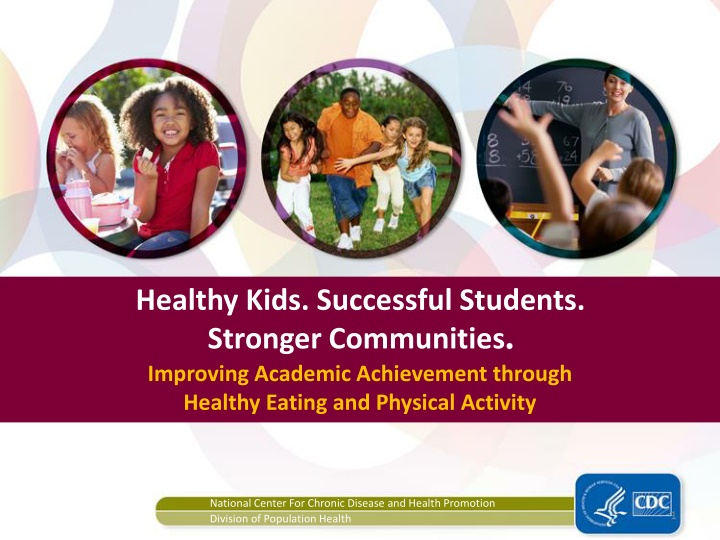
Improving Academic Achievement Through Healthy Eating and Physical Activity
"Discover the vital connection between healthy eating, physical activity, and academic success. Learn how school programs can enhance student achievement by promoting a healthy lifestyle. Find actionable steps and valuable resources to support wellness in schools."
Uploaded on | 1 Views
Download Presentation

Please find below an Image/Link to download the presentation.
The content on the website is provided AS IS for your information and personal use only. It may not be sold, licensed, or shared on other websites without obtaining consent from the author. If you encounter any issues during the download, it is possible that the publisher has removed the file from their server.
You are allowed to download the files provided on this website for personal or commercial use, subject to the condition that they are used lawfully. All files are the property of their respective owners.
The content on the website is provided AS IS for your information and personal use only. It may not be sold, licensed, or shared on other websites without obtaining consent from the author.
E N D
Presentation Transcript
Healthy Kids. Successful Students. Stronger Communities Improving Academic Achievement through Healthy Eating and Physical Activity National Center For Chronic Disease and Health Promotion Division of Population Health 1
Objectives Describe the evidence supporting the link between healthy eating, physical activity, and improved academic achievement. Identify key messages and benefits of addressing healthy eating and physical activity in schools to improve academic achievement and motivate stakeholders to take action. Identify at least three actions that can be implemented by states, school districts, schools, parents, and/or students to support healthy eating and physical activity in schools and improve academic achievement. Identify at least two resources that can be used to explain the relationship between healthy eating, physical activity, and academic achievement. 2
Health is Academic Because . . . Helping young people stay healthy is a fundamental part of the mission of our schools Health behaviors are associated with academic achievement School health programs can help improve students academic achievement 3
No matter how well teachers are prepared to teach, no matter what accountability measures are put in place, no matter what governing structures are established for schools, educational progress will be profoundly limited if students are not motivated and able to learn. Health related problems play a major role in limiting the motivation and ability to learn ~Charles Basch http://www.equitycampaign.org/i/a/document/12557_equitymattersvol6_web03082010.pdf 4
Healthy Eating and Academic Achievement Dietary Behavior/Issue Related Academic Achievement Outcomes Increased academic grades and standardized test scores Reduced absenteeism Improved cognitive performance Participation in the School Breakfast Program (SBP) Skipping breakfast Decreased cognitive performance Lack of adequate consumption of specific foods Lower grades Lower grades Higher rates of absenteeism and tardiness Deficits in specific nutrients Lower grades Higher rates of absenteeism Repeating a grade Inability to focus Insufficient food intake 5
Success in School is More Than Just Academics Schools must also consider other factors that affect academic achievement: Healthy Food Options Opportunities To Be Physically Active Healthy Food Options 6
EVIDENCE MESSAGE ACTION Healthy Eating Know the Core Messages Be Ready to Share with Key Stakeholders How They Can Take Action Academic Achievement AND The Audience- Specific Messages Physical Activity 7
Academic Achievement Academic performance Class grades Standardized tests Graduation rates Education behavior Attendance Drop out rates Behavioral problems at school Students cognitive skills and attitudes Concentration Memory Mood 9
Percentage of High School Students Who Drank a Can, Bottle, or Glass of Soda or Pop at Least One Time Per Day,* by Type of Grades Earned (Mostly A s, B s, C s or D s/F s), 2009** 100 80 engaged in behavior % of students who 60 47 36 40 29 22 20 0 Drank soda or pop Mostly A's Mostly B's Mostly C's Mostly D's/F's *Drank a can, bottle, or glass of soda or pop (not including diet soda or diet pop) at least one time per day during the 7 days before the survey. **p<.0001 after controlling for sex, race/ethnicity, and grade level. United States, Youth Risk Behavior Survey, 2009, http://www.cdc.gov/healthyyouth/health_and_academics/data.htm 10
Physical Activity Physical education Recess Classroom-based Extracurricular Results School-based physical activity can: Help improve academic performance. Have a positive impact on education behaviors and cognitive skills. www.cdc.gov/HealthyYouth/health_ and_academics/pdf/pa-pe_paper.pdf 11
Physical Activity and Academic Achievement Related Academic Achievement Outcomes Physical Activity Practice Students who are physically active Have better grades, better school attendance, and better classroom behaviors Increased physical activity and physical fitness levels Improved cognitive performance Increased participation in physical education class Better grades, standardized test scores, and classroom behavior Time spent in recess Improved cognitive performance and classroom behaviors Participation in brief classroom physical activity breaks Improved cognitive performance, classroom behaviors, and education outcomes Participation in extracurricular physical activities Higher GPAs, lower drop-out rates, and fewer disciplinary problems 12
Percentage of High School Students Who Did Not Play on at Least One Sports Team,* by Type of Grades Earned (Mostly A s, B s, C s or D s/F s), 2009** 100 80 60 engaged in behavior % of students who 60 48 41 40 33 20 0 Did not play on at least one sports team Mostly A's Mostly B's Mostly C's Mostly D's/F's *Run by their school or community groups during the 12 months before the survey. **p<.0001 after controlling for sex, race/ethnicity, and grade level. United States, Youth Risk Behavior Survey, 2009, http://www.cdc.gov/healthyyouth/health_and_academics/data.htm 13
Core Messages Healthy students are better learners Schools can influence eating and physical activity behaviors Healthy, successful students help build strong communities. All students deserve the opportunity to be healthy and successful 15
Audience-specific Messages Audience Benefits to the Audience States Help reduce barriers to learning More likely to have higher levels of education Contributes to a better prepared workforce School Districts Increased attendance rates Increased graduation rates Higher district-wide test scores and grades Schools Meet educational goals Decreased rates of student absenteeism Fewer behavioral problems Higher school-wide test scores and grades Parents Opportunities for your child to practice healthy behaviors Help your child become better learners Students Feel better Increase their concentration Have better grades and test scores 16
Share the Message Consistently share the evidence, key messages, and benefits with key stakeholders Include this topic in professional development for district and school staff Ask parents to support and promote the healthy eating and physical activity as a way to improve academic achievement Use meaningful success stories that support healthy eating and physical activity as a way to improve academic achievement 17
Remember . . . It is our responsibility to share the evidence and important link between healthy eating, physical activity, and improved academic achievement with state and local policy makers, state and local school boards, key community organizations, parents, and anyone else interested in equipping children to be healthy and successful in school. 18
TAKE ACTION 19
Who Can Take Action? States Schools Districts Schools Parents Students 20
Take Action Establish an agenda to support health in schools Develop and implement key policies Provide appropriate guidance, technical assistance, and professional development Implement effective, high-quality programs and practices Ensure accountability 21
Examples of Actions State Create a partnership between departments of health and education to support the connection between health and academic achievement Provide professional development and technical assistance to school districts and schools on healthy school nutrition environments and a comprehensive approach to physical activity in schools School Districts Establish, implement, and monitor local school wellness policies Collect data on health and educational behaviors and outcomes to assess the benefits of school health policies and practices 22
Examples of Actions Schools Establish a school health advisory council or wellness committee Provide healthy food Provide physical education programs Parents Be involved in school health activities at your child s school Ask the school to provide educational opportunities for you to help increase access to healthy eating and physical activity in your child s school Students Participate on state, district, and/or school health advisory councils or other health-related committees Lead activities in your school that promote eating healthy and being physically active 23
Health-Risk Behaviors and Academic Grades Fact Sheets http://www.cdc.gov/healthyyouth/health_and_academics/data.htm 26
New CDC Health and Academic Resources Health and Academic Achievement overview document Presentation slides with notes Podcast for health and academics Nutrition Physical activity Chronic conditions 27
Health in Mind Focuses on several initiatives and policies that can benefit the health and well-being of students Provides strategies that federal agencies can support to create the conditions for health and learning in our nation s schools Provides recommendations that can be addressed at the state, district, and school levels http://www.nasmhpd.org/docs/PreventionResources/Health_in_Mind_Report.pdf 28
The Learning Connection Demonstrates that physical activity supports academic achievement, well-nourished kids learn better and that healthier practices in schools can increase school revenue Provides a roadmap for parents, educators, school administrators and school volunteers to create healthier school environments http://www.actionforhealthykids.org/storage/documents/pdfs/afhk_ thelearningconnection_digitaledition.pdf. 29
The Wellness Impact Highlights that improved nutrition and physical activity can help lead to better academic performance Serves as a launch pad to ignite the conversation about how all sectors of society can work together to create an environment for children to reach their full potential. http://www.nationaldairycouncil.org/ChildNutrition/Pages/The-Wellness-Impact-Healthy-Eating-and- Physical-Activity-Helps-Improve-Academic-Performance.aspx 30
THANK YOU! 31
Healthy Kids. Successful Students. Better Communities. Improving Academic Achievement through Healthy Eating and Physical Activity WEB INFORMATION www.cdc.gov/healthyyouth www.cdc.gov/BAM 32





